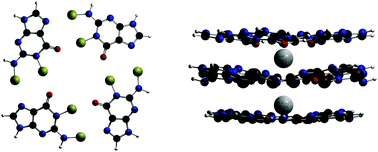Covalency in resonance-assisted halogen bonds demonstrated with cooperativity in N-halo-guanine quartets†
Abstract
Halogen bonds are shown to possess the same characteristics as hydrogen bonds: charge transfer, resonance assistance and cooperativity. This follows from the computational analyses of the structure and bonding in N-halo-base pairs and quartets. The objective was to achieve an understanding of the nature of resonance-assisted halogen bonds (RAXB): how they resemble or differ from the better understood resonance-assisted hydrogen bonds (RAHB) in DNA. We present an accurate physical model of the RAXB based on the molecular orbital theory, which is derived from the corresponding energy decomposition analyses and study of the charge distribution. We show that the RAXB arise from classical electrostatic interaction and also receive strengthening from donor–acceptor interactions within the σ-electron system. Similar to RAHB, there is also a small stabilization by π-electron delocalization. This resemblance leads to prove cooperativity in N-halo-guanine quartets, which originates from the charge separation that occurs with donor–acceptor orbital interactions in the σ-electron system.


 Please wait while we load your content...
Please wait while we load your content...